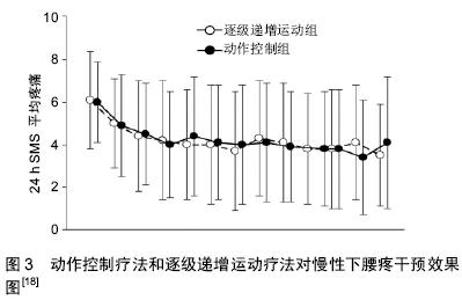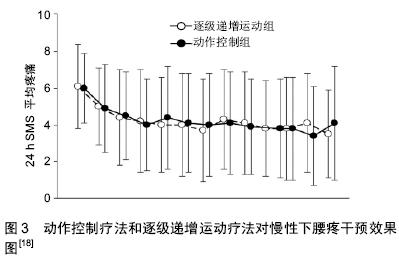| [1] Sahin N, Albayrak I, Durmus B, et al. Effectiveness of back school for treatment of pain and functional disability in patients with chronic low back pain: a randomized controlled trial. J Rehabil Med. 2011; 43(3): 224-229.[2] Rebecca J.Bedard. Active Hamstring Stiffness After Exercise in Women With a History of Low Back Pain. Journal of Sport Rehabilitation.2013;22(1):47 -52.[3] Waddell G, Feder G, Lewis M. Systematic reviews of bed rest and advice to stay active for acute low back pain. Br J Gen Pract. 1997;47(423):647-652.[4] Stankovic A, Lazovic M,Kocic M, et al. Lumbar Stabilization Exercises in Addition to Strengthening and Stretching Exercises Reduce Pain and Increase Function in Patients With Chronic Low Back Pain: Randomized Clinical Open-Label Study. Turkish Journal of Physical Medicine & Rehabilitation. 2012;58(3):177-183.[5] Oesch P. Effectiveness of exercise on work disability in patients with non-acute non-specific low back pain: Systematic review and meta-analysis of randomized controlled trials. Journal of Rehabilitation Medicine. 2010;42 (3):193-205.[6] Hayden JA. Meta-analysis: exercise therapy for nonspecific low back pain. Annals Of Internal Medicine. 2005,142 (9):765-75.[7] van Middelkoop M, Rubinstein SM, Kuijpers T, et al. A systematic review on the effectiveness of physical and rehabilitation interventions for chronic non- specific low back pain. EurSpine J.2011; 20(1): 19-39.[8] Koldas Dogan S, Sonel Tur B, Kurtais Y, et al. Comparison of three different approaches in the treatment of chronic low back pain. Clin Rheumatol. 2008;27(7): 873-881.[9] Tekur P, Singphow C, Nagendra HR, et al. Effect of short-term intensive Yoga program on pain, functional disability, and spinal flexibility in chronic low back pain: a randomized control study. J Altern Complement Med. 2008;14(6): 637-644.[10] Frost H, Klaber Moffet JA, Moser JS, et al. Randomized controlled trial for evaluation of fitness programme for patients with chronic low back pain. BMJ. 1995;310(6973): 151-154.[11] Liddle SD, Gracey JH, Baxter GD. Advice for the management of low back pain: a systematic review of randomized controlled trials. Manual Ther. 2007, 12(4): 310-327.[12] Brox JI, Storheim K, Grotle M, et al. Systematic review of back schools, brief education, and fear- avoidance training for chronic low back pain. Spine J.2008;8(6): 948-958.[13] Roer N, Tulder M, Barendse J, et al. Intensive group training protocol versus guideline physiotherapy for patients with chronic low back pain: a randomized controlled trial. Eur Spine J, 2008;17(9): 1193-1200.[14] Van Middelkoop M, Rubinstein SM, Kuijpers T, et al. A systematic review on the effectiveness of physical and rehabilitation interventions for chronic non- specific low back pain .Eur Spine J. 2011;20 (1): 19-39.[15] Garcia AN,Costa Lda C,da Silva TM,et al. Effectiveness of Back School Versus McKenzie Exercises in Patients With Chronic Nonspecific Low Back Pain A Randomized Controlled Trial. Phys Ther. 2013;93(6):729-747.[16] Garbenyt?, Toma, Poškaitis, Vytautas, Zaveckas, Vidmantas ,et al. Effect of of general versus specialized exercise on movement control of lumbopelvic region in subject with chronic low back pain. Education Physical Training Sport.2013; 90(3): 21-30.[17] Unsgaard-Tøndel M, Fladmark AM, Salvesen Ø, et al. Motor Control Exercises, Sling Exercises, and General Exercises for Patients With Chronic Low Back Pain: A Randomized Controlled Trial With 1-Year Follow-up. Physical Therapy.2010; 90(10):1426-1440.[18] Macedo LG, Latimer J, Maher CG, et al.. Effect of Motor Control Exercises Versus Graded Activity in Patients With Chronic Nonspecific Low Back Pain: A Randomized Controlled Trial. Physical Therapy. 2012; 92(3): 363-377.[19] Hayashida M. Simple Solutions for Low Back Pain. Physical Therapy Products.2013;24(4):44-47.[20] Kang H, Jung J, Yu J.Comparison of trunk muscle activity during bridging exercises using a sling in patients with low back pain. J Sports Sci Med. 2012; 11(3):510-515. [21] Wells C, Kolt GS, Marshall P, et al. Effectiveness of Pilates exercise in treating people with chronic low back pain: a systematic review of systematic reviews. BMC Med Res Methodol. 2013;13:7. [22] Sertpoyraz F, Eyigor S, Karapolat H, et al. Comparison of isokinetic exercise versus standard exercise training in patients with chronic low back pain: a randomized controlled study. Clin Rehabil. 2009;23(3):238-247.[23] Dufek JS,House AJ,Mangus BC,et al.Backward Walking: A Possible Active Exercise for Low Back Pain Reduction and Enhanced Function in Athletes. JEPonline.2011;14(1):17-26. [24] Miyamoto GC, Costa LO, Galvanin T,et al.Efficacy of the Addition of Modified Pilates Exercises to a Minimal Intervention in Patients With Chronic Low Back Pain: A Randomized Controlled Trial. Physical Therapy.2013; 93(3): 309-312.[25] Ligia M. Comparing the Pilates method with no exercise or lumbar stabilization for pain and functionality in patients with chronic low back pain: systematic review and meta-analysis. Clin Rehabil. 2012; 26(1):10-20.[26] Kline JB, Krauss JR, Maher SF, et al.Core Strength Training Using a Combination of Home Exercises and a Dynamic Sling System for the Management of Low Back Pain in Pre-professional Ballet Dancers A Case Series. J Dance Med Sci. 2013;17(1):24-33. [27] Hofmann J, Peters S, Geidl W, et al.Effects of behavioral exercise therapy on the effectiveness of a multidisciplinary rehabilitation for chronic non-specific low back pain: Study protocol for a randomized controlled trial. BMC Musculoskeletal Disorders.2013; 14:89.[28] Fersum KV, Dankaerts W, O'Sullivan PB, et al.Integration of sub classification strategies in randomized controlled clinical trials evaluating manual therapy treatment and exercise therapy for non-specific chronic low back pain: a systematic review.Br J Sports Med.2010;44(14):1054-1062.[29] Slade SC, Molloy E, Keating JL.People with non-specific chronic low back pain who have participated in exercise programs have preferences about exercise: a qualitative study. Aust J Physiother. 2009;55(2):115-121. |

